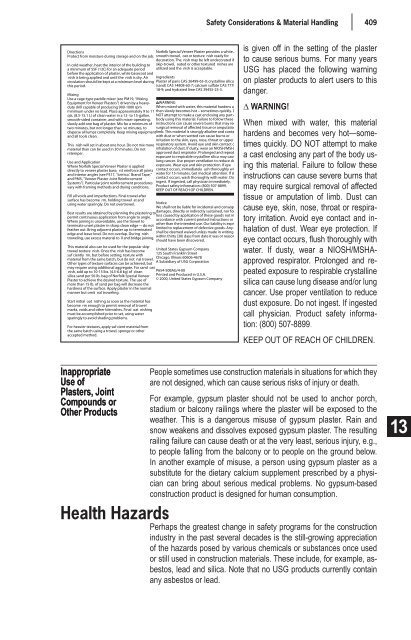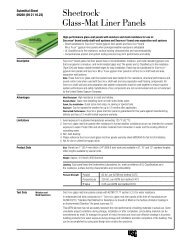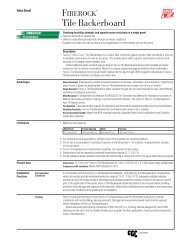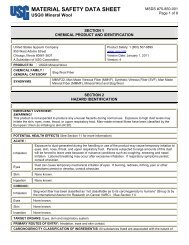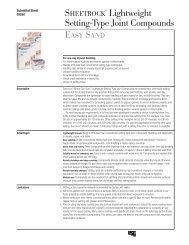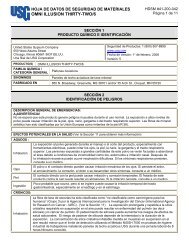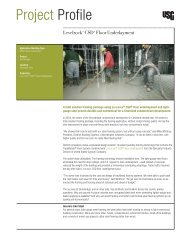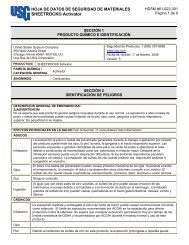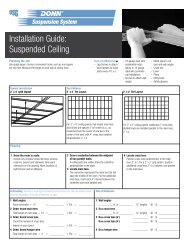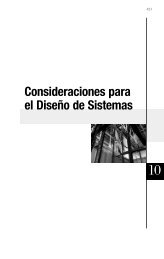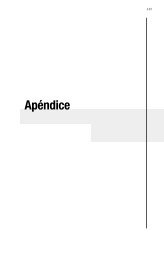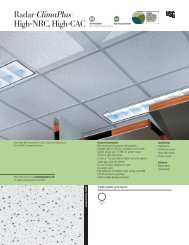13 Safety Considerations & Material Handling - USG Corporation
13 Safety Considerations & Material Handling - USG Corporation
13 Safety Considerations & Material Handling - USG Corporation
Create successful ePaper yourself
Turn your PDF publications into a flip-book with our unique Google optimized e-Paper software.
Directions<br />
Norfolk Special Veneer Plaster provides a white,<br />
Protect from moisture during storage and on the job. smooth trowel, oat or texture nish ready for<br />
decoration. The nish may be left undecorated if<br />
In cold weather, heat the interior of the building to skip-trowel, oated or other textured nishes are<br />
a minimum of 55F (<strong>13</strong>C) for an adequate period utilized and the nish is acceptable.<br />
before the application of plaster, while basecoat and<br />
nish is being applied and until the nish is dry. Air Ingredients<br />
circulation should be kept at a minimum level during Plaster of paris CAS 26499-65-0; crystalline silica<br />
this period.<br />
(sand) CAS 14808-60-7; calcium sulfate CAS 7778-<br />
18-9; and hydrated lime CAS 39455-23-3.<br />
Mixing<br />
Use a cage-type paddle mixer (see PM19, “Mixing<br />
Equipment for Veneer Plasters”) driven by a heavy- WARNING<br />
duty drill capable of producing 900-1000 rpm When mixed with water, this material hardens and<br />
minimum under no load. Place approximately 9 to 11 then slowly becomes hot – sometimes quickly. DO<br />
qts. (8.5-15.1 L) of clean water in a 12- to 15-gallon, NOT attempt to make a cast enclosing any part of the<br />
smooth-sided container, and with mixer operating, body using this material. Failure to follow these<br />
slowly add one bag of plaster. Mix for a minimum of instructions can cause severe burns that may require<br />
two minutes, but not longer than ve minutes, to surgical removal of affected tissue or amputation of<br />
disperse all lumps completely. Keep mixing equipmentlimb.<br />
This material is strongly alkaline and contact<br />
and all tools clean.<br />
with dust or when wetted can cause burns or<br />
irritation to the skin, eyes, nose, throat or upper<br />
This nish will set in about one hour. Do not mix more respiratory system. Avoid eye and skin contact or<br />
material than can be used in 30 minutes. Do not inhalation of dust. If dusty, wear an NIOSH/MSHA-<br />
retemper.<br />
approved dust respirator. Prolonged and repeated<br />
exposure to respirable crystalline silica may cause<br />
Use and Application<br />
lung cancer. Use proper ventilation to reduce dust<br />
Where Norfolk Special Veneer Plaster is applied exposure. Wear eye and skin protection. If eye<br />
directly to veneer plaster base, rst reinforce all joints contact occurs, immediately ush thoroughly with<br />
and interior angles (see P517, “IMPERIAL ® Brand Tape,” water for 15 minutes. Get medical attention. If skin<br />
and PM5, “Veneer Plaster Joint Reinforcement contact occurs, wash thoroughly with water. Do not<br />
Systems”). Particular joint reinforcement procedures ingest. If ingested, call physician immediately.<br />
vary with framing methods and drying conditions. Product safety information: (800) 507-8899.<br />
KEEP OUT OF REACH OF CHILDREN.<br />
Fill all voids and imperfections. Final trowel after<br />
surface has become rm, holding trowel at and<br />
using water sparingly. Do not overtrowel.<br />
Notice<br />
We shall not be liable for incidental and consequential<br />
Best results are obtained by planning the plastering to<br />
damages, directly or indirectly sustained, nor for any<br />
permit continuous application from angle to angle.<br />
loss caused by application of these goods not in<br />
Where joining is unavoidable, use the trowel to<br />
accordance with current printed instructions or for<br />
terminate unset plaster in sharp clean edge—do not<br />
other than the intended use. Our liability is expressly<br />
feather out. Bring adjacent plaster up to terminated<br />
limited to replacement of defective goods. Any claim<br />
edge and leave level. Do not overlap. During nish<br />
shall be deemed waived unless made in writing to us<br />
troweling, use excess material to ll and bridge joining.<br />
within thirty (30) days from date it was or reasonably<br />
should have been discovered.<br />
This material also can be used for the popular skiptrowel<br />
texture nish. Once the nish has become<br />
suf ciently rm, but before setting, texture with<br />
material from the same batch, but do not nal trowel.<br />
Other types of texture surfaces can be achieved, but<br />
A Subsidiary of <strong>USG</strong> <strong>Corporation</strong><br />
may require using additional aggregate. For sand oat<br />
nish, add up to 10-15 lbs. (4.5-6.8 kg) of clean P654-50BAG/4-00<br />
silica sand per 50-lb. bag of Norfolk Special Veneer Printed and Produced in U.S.A.<br />
Plaster to achieve the desired texture. The use of © 2000, United States Gypsum Company<br />
more than 15 lb. of sand per bag will decrease the<br />
hardness of the surface. Apply plaster in the normal<br />
manner but omit nal troweling.<br />
Start initial oat nishing as soon as the material has<br />
become rm enough to permit removal of trowel<br />
marks, voids and other blemishes. Final oat nishing<br />
must be accomplished prior to set, using water<br />
sparingly to avoid shading problems.<br />
For heavier textures, apply suf cient material from<br />
the same batch using a trowel, sponge or other<br />
accepted method.<br />
Inappropriate<br />
Use of<br />
Plasters, Joint<br />
United States Gypsum Company<br />
125 South Franklin Street<br />
Chicago, Illinois 60606-4678<br />
<strong>Safety</strong> <strong>Considerations</strong> & <strong>Material</strong> <strong>Handling</strong> | 409<br />
is given off in the setting of the plaster<br />
to cause serious burns. For many years<br />
<strong>USG</strong> has placed the following warning<br />
on plaster products to alert users to this<br />
danger.<br />
∆ WARNING!<br />
When mixed with water, this material<br />
hardens and becomes very hot—sometimes<br />
quickly. DO NOT attempt to make<br />
a cast enclosing any part of the body using<br />
this material. Failure to follow these<br />
instructions can cause severe burns that<br />
may require surgical removal of affected<br />
tissue or amputation of limb. Dust can<br />
cause eye, skin, nose, throat or respiratory<br />
irritation. Avoid eye contact and inhalation<br />
of dust. Wear eye protection. If<br />
eye contact occurs, flush thoroughly with<br />
water. If dusty, wear a NIOSH/MSHAapproved<br />
respirator. Prolonged and repeated<br />
exposure to respirable crystalline<br />
silica can cause lung disease and/or lung<br />
cancer. Use proper ventilation to reduce<br />
dust exposure. Do not ingest. If ingested<br />
call physician. Product safety information:<br />
(800) 507-8899.<br />
KEEP OUT OF REACH OF CHILDREN.<br />
People sometimes use construction materials in situations for which they<br />
are not designed, which can cause serious risks of injury or death.<br />
Compounds or For example, gypsum plaster should not be used to anchor porch,<br />
Other Products stadium or balcony railings where the plaster will be exposed to the<br />
weather. This is a dangerous misuse of gypsum plaster. Rain and<br />
snow weakens and dissolves exposed gypsum plaster. The resulting<br />
railing failure can cause death or at the very least, serious injury, e.g.,<br />
to people falling from the balcony or to people on the ground below.<br />
In another example of misuse, a person using gypsum plaster as a<br />
substitute for the dietary calcium supplement prescribed by a physician<br />
can bring about serious medical problems. No gypsum-based<br />
construction product is designed for human consumption.<br />
Health Hazards<br />
Perhaps the greatest change in safety programs for the construction<br />
industry in the past several decades is the still-growing appreciation<br />
of the hazards posed by various chemicals or substances once used<br />
or still used in construction materials. These include, for example, asbestos,<br />
lead and silica. Note that no <strong>USG</strong> products currently contain<br />
any asbestos or lead.<br />
chapter<strong>13</strong>.indd 409 1/<strong>13</strong>/2009 10:36:31 AM<br />
<strong>13</strong>


